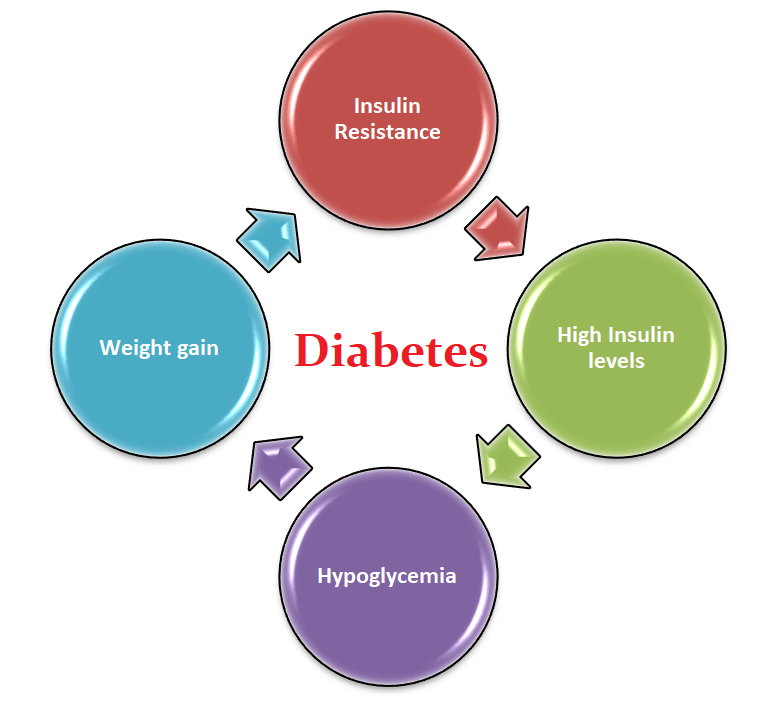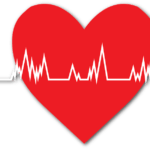Non-insulin-dependent diabetes mellitus (NIDDM) also known as type 2 diabetes mellitus (T2DM), is a chronic illness in which the body does not use insulin properly.
Unlike type 1, type 2 diabetes often does not develop in children, it is most common among older adults (people in their 40’s or 50’s).
However, it can affect children and adolescents that have childhood obesity. T2DM is directly linked to lifestyle habits, physical inactivity, and obesity. 90-95% of all diabetes cases are of type 2 diabetes mellitus.
The main cause of this type of T2DM is Insulin Resistance. Obese persons are at greater risk of having type 2 diabetes as obesity already creates some degree of insulin resistance.
| You may also like to read: |
What is Insulin Resistance?

Insulin resistance is a term used when the body produces the hormone insulin but cannot properly use it, which means that the body has insulin but it won’t be effective in lowering blood sugar levels. As a result, hyperglycemia occurs.
At first, insulin resistance starts mainly in the liver, muscle, and adipose cells. This condition is compensated by increased insulin secretion which maintains glucose levels. This is usually the pre-diabetic stage.
| You may also like to read: |
Symptoms of Non-Insulin Dependent Diabetes Mellitus (T2DM):
People with type 2 diabetes often exhibit the typical signs and symptoms that appear in diabetes. Some of these include
- Frequent urination
- Excessive thirst
- increased appetite
- weight loss
- Blurry vision
- Fatigue
- Slow healing of wounds
- Numbness or tingling in limbs
- Dark skin areas near the neck or armpits
| You may also like to read: |
Causes of Non-Insulin Dependent Diabetes Mellitus (T2DM):
The actual cause of type 2 diabetes is still not clear. Non-Insulin dependent Diabetes mellitus is a multifactorial disease. However, your genes play a major role in the etiology of diabetes mellitus.
According to the American Diabetes Association (ADA), type 2 diabetes has a stronger link to family history as compared to type 1.
However it is rather difficult to determine whether a patient is diabetic due to genetic or other factors. [Ref]
Lifestyle factors also play a great role in the development of T2DM. These include a sedentary lifestyle, physical inactivity, smoking, and alcohol consumption.
According to WHO, 90% of the development of type 2 diabetes is due to being overweight and obese.
Recently, psychological factors such as stress and COVID-19 infection have also been associated with the development of T2DM.
| You may also like to read: |
Risk Factors for T2DM:
Some factors increase the risk of T2DM, if you have a combination of these then the risk is doubled.
Non-Modifiable factors:
- These are the factors that cannot be changed or prevented.
- Age of 45 years or older
- Family history of diabetes
- Ethnicity
Major Risk Factors:
- Obesity
- Metabolic syndrome
- Heart Disease
- High Cholesterol levels
- PCOS
Modifiable Risk Factors
- A diet high in simple carbohydrates
- Physical Inactivity
- Smoking
- Alcohol Consumption
- Stress

| You may also like to read: |
Treatment of Non-Insulin Dependent Diabetes Mellitus (NIDDM):
The treatment of type 2 diabetes involves a mix of medication and lifestyle changes.

Medical Management of NIDDM (T2DM):
The use of metformin monotherapy as an initial treatment is currently recommended by most treatment guidelines.
When lifestyle and single oral antidiabetic medicines fail to treat T2DM, combination therapy with two or more antidiabetic agents is considered. Some of the antidiabetic medicines are:
This helps to lower blood glucose levels and enhance insulin sensitivity. For most patients with type 2 diabetes, it is the first-line treatment.
Sulfonylureas:
These are oral drugs that aid in the production of insulin in the body. These drugs are also called insulin-secretagogues.
They act on the pancreas to secrete more insulin. Hence, these drugs are notorious for causing weight gain and hypoglycemia.
sulfonylureas are among the cheapest medicines and more potent than most antidiabetic medicines.
Thiazolidinediones (TZDs):
These increase the body’s insulin sensitivity. Pioglitazone and Rosiglitazone are the two drugs included in this class of medicines.
These drugs cause fluid retention and weight gain and are contraindicated in patients with heart failure and macular edema.
Meglitinides:
These are short-acting drugs that encourage the pancreas to produce more insulin. Nateglinide and Repaglinide are the two commonly used drugs in this class.
Because these drugs are short-acting, they are preferably used in patients who are at risk of developing hypoglycemia such as those with kidney disease.
Dipeptidyl peptidase 4 (DPP-4) Inhibitors:
These are less potent drugs that aid in the reduction of blood glucose levels. These drugs act by increasing the half-life of incretins (GLP and GIP).
Indirectly, they cause glucose-dependent insulin secretion and improve insulin sensitivity.
These drugs are called euglycemic since these drugs do not cause hypoglycemia. However, when given in combination with insulin and sulfonylureas, they may enhance their effect and result in hypoglycemia.
DPP-IV Inhibitors include Sitagliptin, Vildagliptin, and Linagliptin. These drugs should be avoided in patients with hepatobiliary disease and those with a history of pancreatitis.
Sodium-glucose cotransporter-2 (SGLT2) Inhibitors:
These aid in the removal of sugar from the body through urine produced by the kidneys. SGLT2 Inhibitors act via the kidneys and hence they do not cause hypoglycemia.
SGLT2 Inhibitors include dapagliflozin, empagliflozin, canagliflozin, and ertugliflozin. These drugs may result in significant weight loss in some patients.
Apart from their role in the treatment of diabetes, SGLT2 Inhibitors are now being increasingly used in patients with heart failure with or without diabetes.
These drugs also lower blood pressure and uric acid, however, they may increase the risk of fractures, cause dyslipidemia, and increase the risks of UTIs (urinary tract infections).
In fact, UTI and genital yeast infections are the most common side effects of SGLT2 Inhibitors.
Glucagon-like peptide-1 agonists:
These help to delay digestion and regulate blood sugar levels. This class of drugs includes Liraglutide, Dulaglutide, and Semaglutide.
Semaglutide is a novel GLP-1 analog that is associated with significant weight loss apart from its role in the treatment of diabetes mellitus.
These drugs cause glucose-dependent insulin secretion and cause significant weight loss. In fact, two of the GLP-1 analogs, Liraglutide (Saxenda) and Semagltuide (Rybelsus, Ozempic, and Wegovy) are approved by the FDA as weight loss medicines.
Twincretins (Dual GLP-1 and GIP analogs):
The only drug in this group is Tirzepatide, available under the brand name, Mounjaro. It mimics the action of both GLP-1 and GIP and is considered the most potent diabetes drug.
Mounjaro is associated with an A1C reduction of more than 2%. It is also one of the most potent diabetes drugs that cause significant weight loss. However, as a weight loss drug, its approval by the FDA is still pending. The manufacturer, Eli Lilly, is hoping that it will get approved by the end of 2023 as a weight loss drug in non-diabetic individuals.
Miscellaneous Drugs:
Other drugs used in the treatment of diabetes include acarbose and miglitol. These drugs inhibit the absorption of dietary carbohydrates.
Insulin:
Non-insulin-dependent Diabetes Mellitus, as the name suggests, does not require insulin for lowering blood glucose. However, this is only true in the early stages of the development of diabetes mellitus.
When a person is diagnosed with NIDDM or T2DM, 50% of his Beta-Cells in the pancreas have already been lost. With time, the rest of the beta-cells may die. Insulin secretion may rapidly decline and the person may become Insulin-dependent.
One study suggests that combination therapy is more beneficial as compared to monotherapy. [Ref]
Updates:
Two latest drugs that have shown superiority in clinical trials as potent diabetes and weight loss drugs include Retatrutide and CagriSema.
These drugs may soon get approval for the treatment of obesity and diabetes (diabesity).
| You may also like to read: |
Why do you need more medication over time?
After being diagnosed with type 2 diabetes, it’s more difficult to meet treatment goals, even if medication, exercise, food, or other diabetes management strategies haven’t changed—this is normal.
This is because all these medical and lifestyle management options delay the progression of the disease and help in avoiding complications.
But the disease still progresses even at a slow pace. So, you might need more medications as you age.
Furthermore, your beta cells get tired over time. There is a decline in the number of beta-cells and insulin secretion is also insufficient. Patients may need more drugs and insulin to control their high blood glucose levels.
| You may also like to read: |
Lifestyle Management:
Lifestyle management includes dietary patterns, smoking, alcohol consumption, and physical activity. This is the most important aspect of treating T2DM. Some people may even reverse their diabetes with aggressive lifestyle changes.
Dietary Changes:
Diet is a key strategy for maintaining good heart health and blood glucose levels in a healthy range.
The diet that is recommended for people with type 2 diabetes is the same as a regular diet that can be followed by almost everyone. It is all summed up by some essential tips:
- Choose a variety of nutrient-dense foods that are low in empty calories.
- Make an effort to be careful of portion sizes and to quit eating when you’re satisfied.
- Read food labels carefully to determine the amount of sugar or carbohydrates in a serving size.
A vast amount of research suggests that excessive use of refined grains, sugar-sweetened beverages, red and processed meat, and alcohol may raise diabetes risk, while consumption of whole-grain cereal, vegetables, dairy, legumes, and nuts has the opposite effect, regardless of body weight change. [Ref]
Many dietary practices have been studied, but no one diet can be believed to cure any problem. So, the general rule is consuming a diet that is:
- Rich in vegetables and whole grains.
- Includes low glycemic fruits.
- Is low in saturated and trans-fat.
- Includes non-fat dairy products, poultry, and fish.
- Limits the consumption of sugary snacks.
- High in dietary fiber (25-30g/day).
- Limits red meat and processed meat.
- Includes nuts, legumes, and beans.
A large 6-year study of people with impaired glucose tolerance suggests that diet and lifestyle interventions decrease the risk of diabetes. [Ref]
Exercise for T2DM (NIDDM):
Physical inactivity is now regarded as one of the world’s most serious public health issues. It has been shown to contribute to a 30-50 percent reduction in the development of T2DM.
The majority of people should be able to participate in any form of physical activity. Walking, for example, the most popular kind of physical activity has been demonstrated to reduce the relative risk of T2DM.
One study suggests that 150 min physical activity per week causes a 60% reduction in the risk of T2DM.[Ref]
| You may also like to read: |
Weight Loss and Obesity Management for Non-Insulin Dependent Diabetes Mellitus (NIDDM):
Obesity is one of the major risk factors for T2DM, which is caused by an imbalance in energy intake and expenditure.
Adipose tissue, especially that around internal organs (e.g., visceral fat), can emit a variety of pro-inflammatory adipokines, and the secretion of these cytokines is altered when adipose tissue mass increases, contributing to T2DM due to metabolic abnormalities.
WHO recommends the consumption of a high-fiber diet, decrease intake of energy-dense and nutrient-poor meals, and increase consumption of nutrient-dense and antioxidant-rich food sources along with regular physical activity to reduce the risk of obesity.
One study suggests that even a weight loss of 1 kg is linked to a 16 percent reduction in the development of T2DM.[Ref]
[web_stories title=”true” excerpt=”false” author=”false” date=”false” archive_link=”false” archive_link_label=”https://dibesity.com/web-stories/diabetes-management/” circle_size=”150″ sharp_corners=”false” image_alignment=”left” number_of_columns=”1″ number_of_stories=”3″ order=”DESC” orderby=”post_title” view=”circles” /]
| You may also like to read: |




